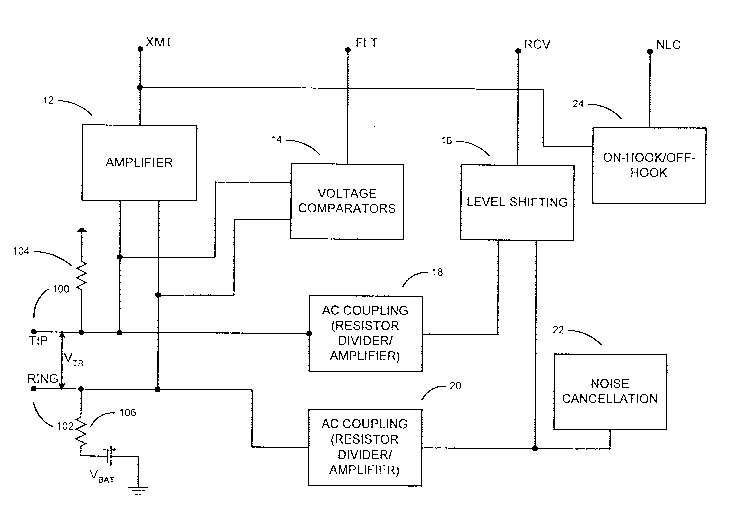Some of the information on this Web page has been provided by external sources. The Government of Canada is not responsible for the accuracy, reliability or currency of the information supplied by external sources. Users wishing to rely upon this information should consult directly with the source of the information. Content provided by external sources is not subject to official languages, privacy and accessibility requirements.
Any discrepancies in the text and image of the Claims and Abstract are due to differing posting times. Text of the Claims and Abstract are posted:
| (12) Patent Application: | (11) CA 2161170 |
|---|---|
| (54) English Title: | BATTERY FEED CIRCUIT |
| (54) French Title: | CIRCUIT D'ALIMENTATION DE BATTERIES |
| Status: | Deemed Abandoned and Beyond the Period of Reinstatement - Pending Response to Notice of Disregarded Communication |
| (51) International Patent Classification (IPC): |
|
|---|---|
| (72) Inventors : |
|
| (73) Owners : |
|
| (71) Applicants : |
|
| (74) Agent: | KIRBY EADES GALE BAKER |
| (74) Associate agent: | |
| (45) Issued: | |
| (22) Filed Date: | 1995-10-24 |
| (41) Open to Public Inspection: | 1996-06-20 |
| Examination requested: | 1995-10-24 |
| Availability of licence: | N/A |
| Dedicated to the Public: | N/A |
| (25) Language of filing: | English |
| Patent Cooperation Treaty (PCT): | No |
|---|
| (30) Application Priority Data: | ||||||
|---|---|---|---|---|---|---|
|
Resistive circuits are provided at the tip and ring of the battery feed circuit as
a method of alleviating the need for bulky DC transformers or complex integratedcircuitry. The voltage is monitored through a set of comparators eliminating theexpense of maintaining fused resistors. The voltages for voice or data transmission is
amplified prior to being transmitted. Received signals are AC coupled, with proper
biasing, onto the tip and ring lines. Any AC noise on the tip and ring line is shifted
180 degrees out of phase and re-inserted on the line to cancel the noise. As an
enhancement to the battery feed circuit, another voltage comparator is added to check
the line for DC current signifying an off hook condition.
Note: Claims are shown in the official language in which they were submitted.
Note: Descriptions are shown in the official language in which they were submitted.

2024-08-01:As part of the Next Generation Patents (NGP) transition, the Canadian Patents Database (CPD) now contains a more detailed Event History, which replicates the Event Log of our new back-office solution.
Please note that "Inactive:" events refers to events no longer in use in our new back-office solution.
For a clearer understanding of the status of the application/patent presented on this page, the site Disclaimer , as well as the definitions for Patent , Event History , Maintenance Fee and Payment History should be consulted.
| Description | Date |
|---|---|
| Application Not Reinstated by Deadline | 1999-05-25 |
| Inactive: Dead - No reply to s.30(2) Rules requisition | 1999-05-25 |
| Inactive: Status info is complete as of Log entry date | 1999-02-08 |
| Deemed Abandoned - Failure to Respond to Maintenance Fee Notice | 1998-10-26 |
| Inactive: Abandoned - No reply to s.30(2) Rules requisition | 1998-05-25 |
| Inactive: S.30(2) Rules - Examiner requisition | 1998-02-24 |
| Application Published (Open to Public Inspection) | 1996-06-20 |
| All Requirements for Examination Determined Compliant | 1995-10-24 |
| Request for Examination Requirements Determined Compliant | 1995-10-24 |
| Abandonment Date | Reason | Reinstatement Date |
|---|---|---|
| 1998-10-26 |
The last payment was received on 1997-08-27
Note : If the full payment has not been received on or before the date indicated, a further fee may be required which may be one of the following
Patent fees are adjusted on the 1st of January every year. The amounts above are the current amounts if received by December 31 of the current year.
Please refer to the CIPO
Patent Fees
web page to see all current fee amounts.
| Fee Type | Anniversary Year | Due Date | Paid Date |
|---|---|---|---|
| MF (application, 2nd anniv.) - standard | 02 | 1997-10-24 | 1997-08-27 |
Note: Records showing the ownership history in alphabetical order.
| Current Owners on Record |
|---|
| AT&T CORP. |
| Past Owners on Record |
|---|
| DEWAYNE ALAN SPIRES |
| IAN ANDREW SCHORR |